The ad server development and integration in the dynamic world of programmatic advertising has proven to be a smart move toward effective ad inventory monetization. In the course of achieving seamless collaboration between brands and businesses, it is necessary to throw light on the necessity of reliable ad server software to amplify the impact of their marketing & earning efforts. An ad server benefits both sides: advertisers reach their target audience more effectively, boosting their marketing game, while publishers effortlessly generate revenue by displaying ads. It’s a win-win situation for everyone involved in the digital advertising procedure. As per the research, the global ad server market size was worth around $2.3 billion in 2021. However, by 2032, that number is expected to grow to $4.8 billion[1]!
Are you looking forward to exploring ad server software development? Then, this blog is for you. Here, we focus on multiple aspects, such as what is an ad serving platform, how it works, different types of ad servers, and many more.
What is an Ad Server?
An ad server is a tech-enabled tool or software that acts as a decision maker in online advertising transactions, including identifying best-suited ad displaying on the publisher’s platform, providing advertisers with ad performance reports, and allowing them to optimize campaigns in real-time. This prominent component of the AdTech ecosystem facilitates the effective management & optimization of ad campaigns across online channels to promote the environment of achieving advertising objectives efficiently.
The top ad-serving technology empowers advertisers to upload campaign creatives and set various parameters, including targeted audience, demographic information, budget, etc., in order to reach the right audience and conclude with defined outcomes. On the other hand, ad server platform development enables publishers to find the perfect tenants (ads) for their digital platform that meet their targeted goals, gather information on traffic volume, and manage inventory and audience.
Yes, you assumed it right! There are two different types of ad servers that work on two different endpoints, which we will discuss in the upcoming section.
What are the Different Types of Ad Servers?
Ad servers are categorized based on the entities who use it – first-party ad servers and third-party ad servers. These both come with their own set of advantages and unique features. Let’s discuss these in detail:
First-party Ad Server (Publisher or Sell-side)
This is the type of ad serving technology used by publishers, the owners of websites, apps, or any digital platform, to manage and deliver ads on their own digital properties. It allows them to control everything from which ads are displayed to how much they charge advertisers. This advertising server tends to be more powerful, with enhanced capabilities of data storage and reporting to drive impactful decisions.
Third-party Ad Server (Advertiser-side)
This type of ad server software can serve as a medium for advertisers to connect & interact with multiple publishing platforms. Ad servers help ad agencies to operate smartly, from handling ad campaigns to distributing and optimizing them across different networks and formats, like video-based, image-based, and programmatic CTV advertising. They also allow advertisers to target specific audiences and track campaign performance.
How Does an Ad Server Work?
The emergence of ad server platforms in the early 1990s changed programmatic advertising. This new tool allowed businesses & brands to control and manage ad displays without changing their websites’ backend. In 1995, FocaLink Media Services performed ad server development that simplified ad and performance management. Over time, ad servers have evolved with new features such as targeting and budget management. They later evolved into first- and third-tier ad servers, offering tailored solutions for effective ad management. In today’s world, ad server software has become an essential component in accomplishing online advertising goals in the landscape that evolves with time.
In this section, we will focus on how first-tier and third-tier ad servers work:
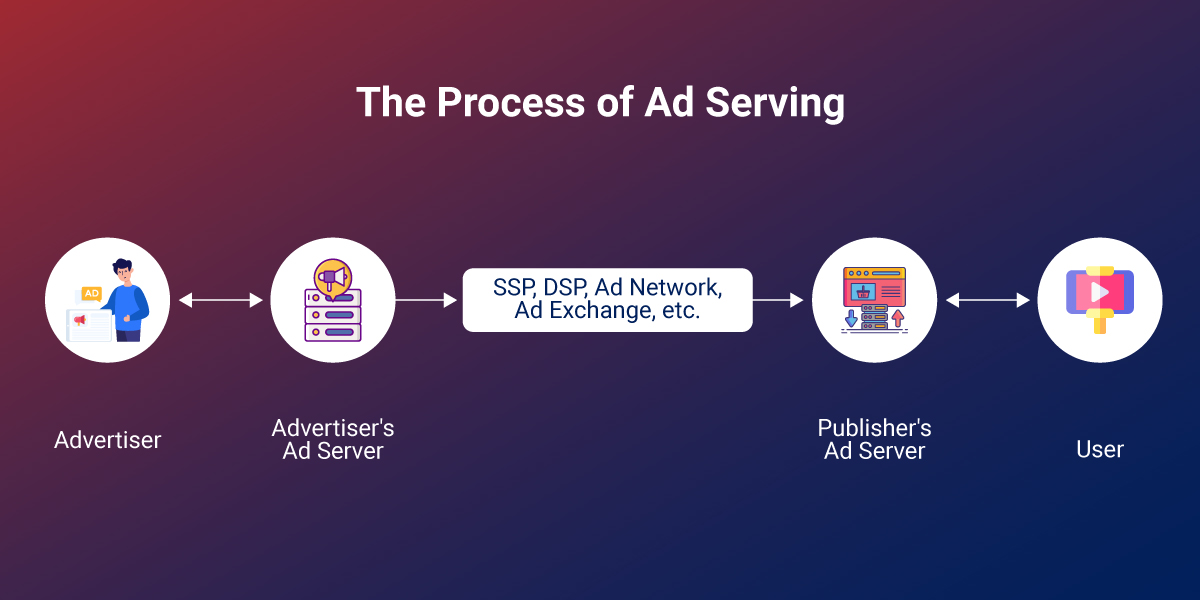
How Does First-Party Ad Server Work?
First-party ad-serving technology works within the context of the publisher’s digital platform and acts as a control center for ad display. Below is the full advertising operation cycle performed by the ad server for the publisher:
- Ad Placement Tagging: Imagine you’re a painter, and your canvas is the publisher’s website/app/digital platform. The ad placement tags are your guiding lines, helping you decide where to paint. These tags i.e. code snippets indicate where the ads will be placed.
- Sending an Ad Request: When a user visits or interacts with publisher’s platform, it’s like they’re knocking on the door of the ad server. This knock is the ad request, asking for an ad to be displayed in a specific ad placement location. It’s the trigger that sets the ad-serving process in motion.
- Ad Selection and Targeting: The first ad server is like a skilled archer, using its targeting capabilities to select the most relevant ad from the available inventory. It considers factors such as the user’s demographics, behavior, and the content of the webpage or app. Each ad is an arrow, and the goal is to hit the bullseye – the user’s interest.
- Ad Serving: Once the ad server has selected the perfect ad creatives, it delivers it in real-time to the ad placement location on the webpage or within the app.
- Tracking and Reporting: The ad server doesn’t just serve the ads and forget about them. It keeps track of various metrics such as impressions, clicks, and conversions. This data provides valuable feedback to the publisher about the performance of the ads.
How Does Third-Party Ad Server Work?
As we discussed, these function from the advertiser’s end and operate differently from the ad server for publishers. Let’s understand how a third-party ad server works:
- Advertiser Campaign Setup: For a successful ad campaign, defining the campaign parameters paves the way for better outcomes. Through third-party ad servers, advertiser defines their campaign parameters, set a budget, and create their ad assets. These ad assets can include anything from banner ads to videos.
- Ad Tag Generation: Once the campaign is set up, the advertiser’s ad server generates a unique ad tag for each ad creative or campaign. We can consider it as a digital footprint that is unique for each ad.
- Ad Network Integration: In this step, third parties integrate ad tags with multiple ad networks or ad exchanges. This enables the ad network to go a step further by requesting ad creatives whenever suitable ad placement opportunities arise.
- Auction and Selection: Real-time bidding in ad exchange is conducted by considering key parameters defined such as targeting, bid prices, etc. Once the advertiser that bids the highest, wins in the race, ad exchange requests for ad creatives from the advertiser’s ad server.
- Delivery and Display Ad: The Advertiser’s ad server fulfills the ad exchange request by delivering ad creative and then serves the ad on the publisher’s platform.
Benefits of Ad Server Platform Development in Programmatic Advertising
Ad servers have evolved and become essential tools akin to smartphones for brands and agencies. They are no longer just tag transporters but vital technologies that enhance ad performance and ROI and provide a holistic view of marketing efforts. Modern ad servers act as an advertiser’s mission control, utilizing data for personalization, immediate performance measurement, and automated optimization.
The right ad server can convert regular digital advertising into direct business value and foster brand growth. Let’s explore the benefits of ad server platform development in programmatic advertising.
Benefits for Publishers
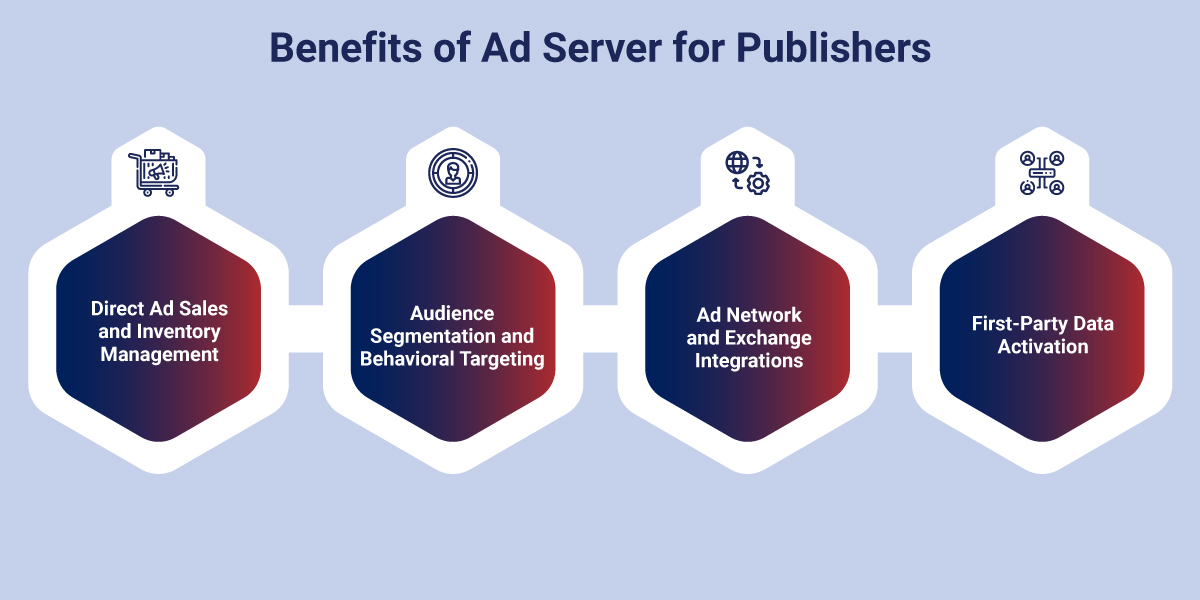
- Direct Ad Sales and Inventory Management: Ad servers empower publishers with the ability to directly sell and manage their ad inventory. With proper control, publishers can effectively manage ad placements, set pricing for ad space, and get visibility on available ad space for better decision-making.
- Audience Segmentation and Behavioral Targeting: The ad server acts as a web server that fetches, stores, and retrieves data. As an information broadcaster, ad server technology allows publishers to collect insights on website visitors. Based on data such as browsing behavior, interests, and demographics, creating audience segments becomes a more seamless process for advertisers. This also allows them to place more targeted ads and create more value with each ad placement.
- Ad Network and Exchange Integrations: By leveraging this capability of the ad servers, publishers can tap into the marketplace with a range of advertisers and demand side platforms (DSP) that lead to improved ad placement rates.
- First-Party Data Activation: Publishers can leverage their first-party data, such as user registration data or content consumption patterns, within their ad server. This enables more granular audience targeting and personalized ad experiences.
Benefits for Advertisers
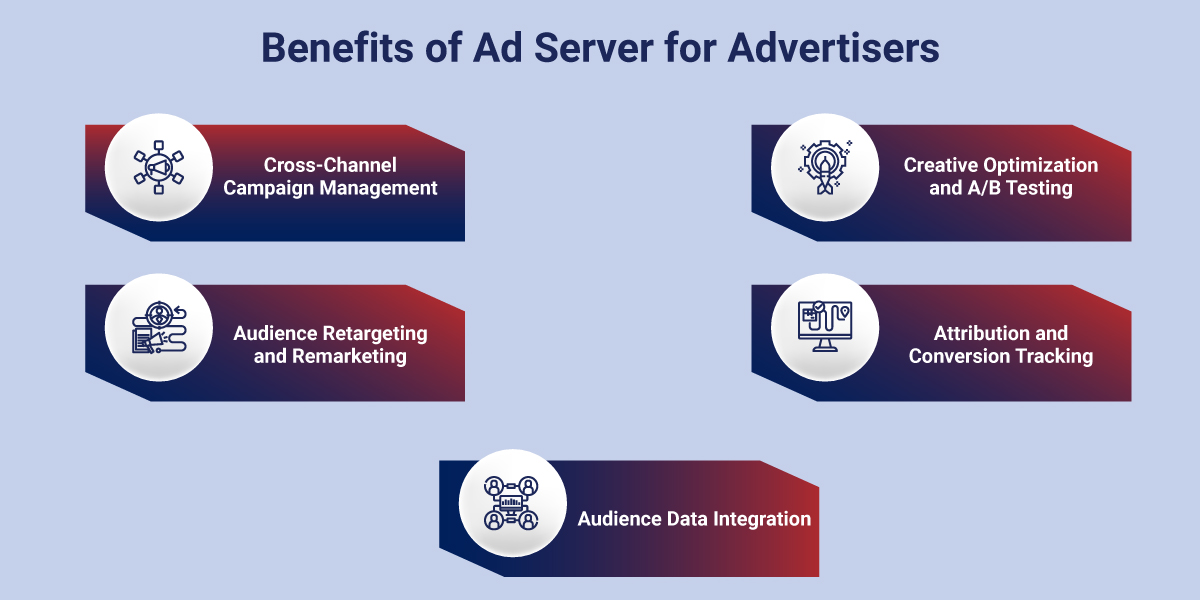
- Cross-Channel Campaign Management: Embracing ad servers allows ad agencies to manage and optimize campaigns across various channels, including display, video, mobile, and social media, from a single platform.
- Audience Retargeting and Remarketing: Real-time retargeting and remarketing enhance campaign optimization. Ad servers allow advertisers to retarget and remarket ads to users based on the campaign performance, which directly impacts the ad relevance, conversion rates, and overall campaign effectiveness.
- Creative Optimization and A/B Testing: Ad servers facilitate creative optimization by enabling advertisers to test different ad creatives, formats, and messaging across various audience segments. This overall process offers advertisers a superpower to easily segregate the most effective creative assets and messaging.
- Attribution and Conversion Tracking: It offers granular attribution and conversion tracking capabilities that help get an in-depth observation of the impact of their campaigns on desired actions, such as website visits, lead generations, or sales.
- Audience Data Integration: Advertisers can integrate their own first-party data or leverage third-party data sources within the ad server platform. The integration allows advertisers to go for more precise audience targeting and personalized ad experiences. Improved campaign relevance and performance come hand-in-hand.
Common Features of Ad Server Software
The ad server development cycle starts with predefined features and functionalities. It can undoubtedly be customized based on the needs of advertisers, ad agencies, and publishers to make it powerful. In this section, we walk you through the common features of ad serving platforms.
- Ad serving and management: It is the most common and purpose-served feature of ad server software. This feature delivers ads to users’ devices and offers full control over ad management.
- Targeting capabilities: This feature within the ad server allows targeting audiences based on specific demographics or user behavior.
- Real-time reporting and analysis: This provides insights into ad campaign performance through real-time tracking and data gathering.
- Third-party integration: Ad servers are usually designed to integrate with other platforms, such as data management platforms, demand-side platforms, and customer relationship management for seamless data exchange and campaign management.
- User-friendly interface: Ad server platforms offer an intuitive and user-friendly UI that enables publishers and advertisers to operate the entire software smoothly.
- Mobile ad serving: This feature serves ads on mobile devices and offers optimization for mobile viewing as well.
- Creative support: In order to enable advertisers to create engaging and diverse ad campaigns, this feature is key and supports multiple ad formats, including video, image, native, etc.
How Can Rishabh Software Help You With Custom Ad Server Software Development?
As a leading AdTech software development company, Rishabh Software has dedicated years to delivering value-driven, custom advertising software solutions that propel success in ad transactions. With our comprehensive approach to ad server development, we build high-performance ad servers that offer end-to-end control over ad placement, streamline collaboration between brands and businesses, and provide in-depth analytics.
We are known for our capabilities in strengthening ad servers by integrating multiple platforms such as RTB, supply-side platforms, ad exchange & network, many more. Also, we are helping the global advertising industry players optimize existing AdTech infrastructure and reinforce the programmatic advertising ecosystem.
Frequently Asked Questions
Q: What are some popular ad server examples in the AdTech industry?
A: Some of the most popular ad servers in the AdTech ecosystem include:
- Google Ad Manager
- Epom Ad Server
- OpenX
- Kevel
Q: What is the cost of an ad server?
A: The ad serving costs are highly affected by several factors, such as which service provider you choose, features and functionalities, and scale of implementation.
Q: What is open source or self-hosted ad servers?
A: Open-source and self-hosted ad-serving solutions are also available. Here’s a simplified definition for each:
- Open-source ad servers: These are free, open-source ad serving platforms whose source code can be viewed by anyone, modified by any developer, and easily redistributed. They offer transparency and customization options for users who prefer open-source software.
- Self-Managed ad serving: Ad servers are deployed and run by individuals or companies on their own servers or cloud infrastructure. In other words, hosting ad-serving software independently allows full control of setting up, managing data, and customizing an ad-serving platform.
Footnotes:
1. https://www.businessresearchinsights.com/market-reports/ad-server-market-108814




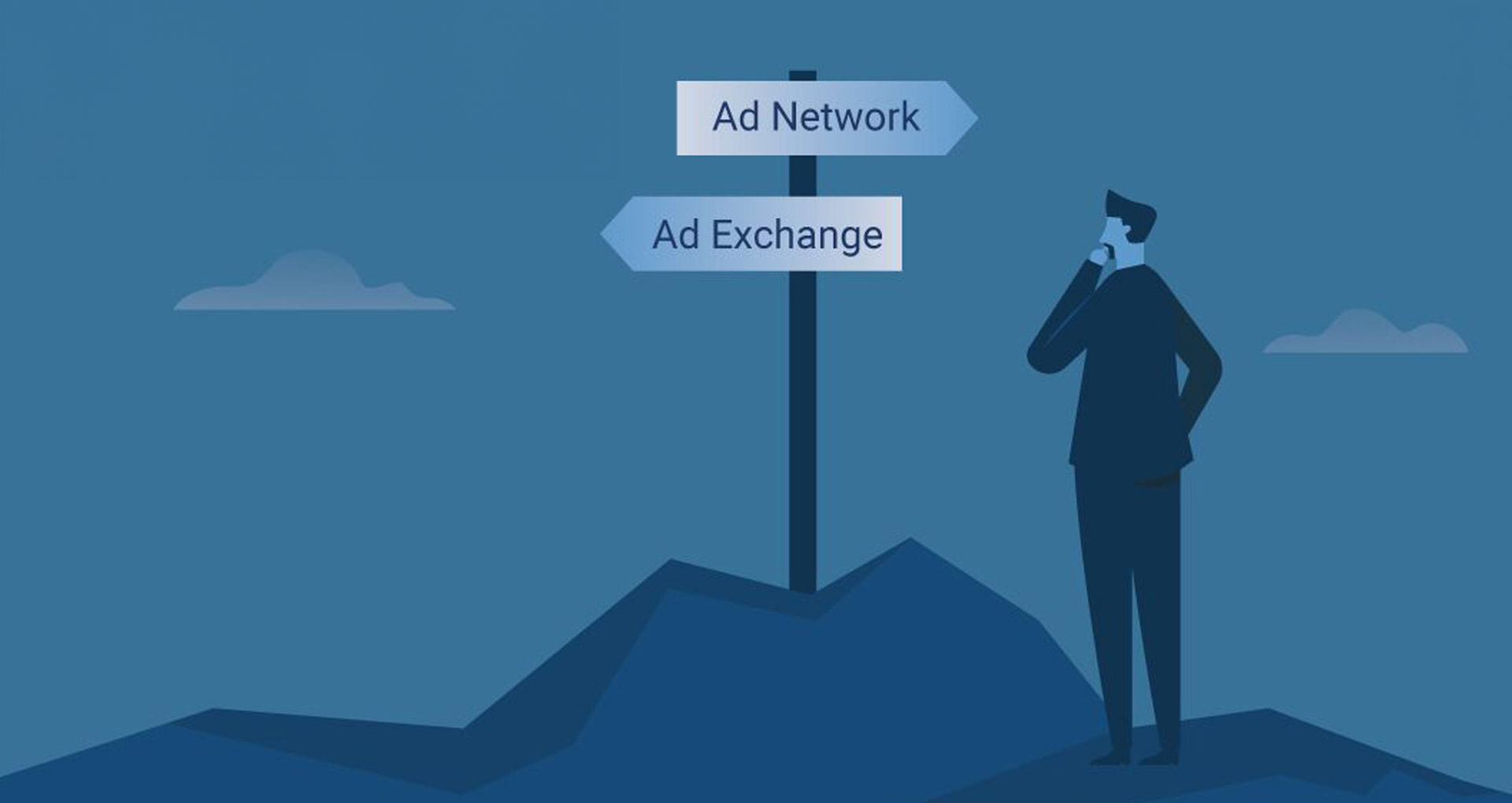
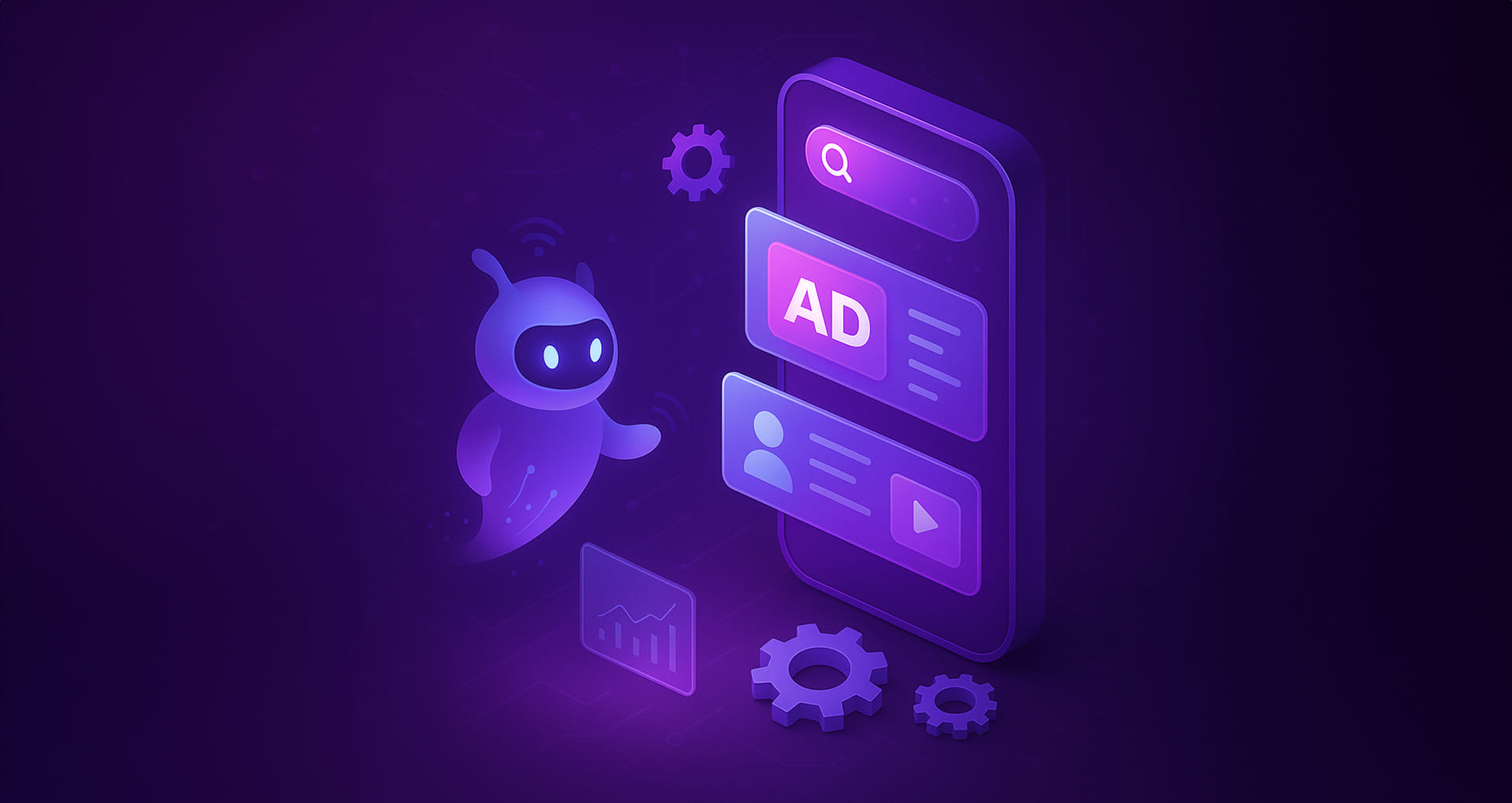





 30 Min
30 Min


